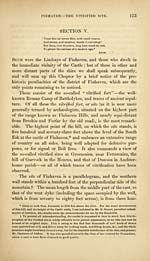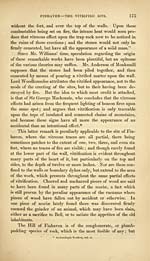Download files
Complete book:
Individual page:
Thumbnail gallery: Grid view | List view

174 LAND OF THE LINDSAYS.
dred and seventy to eighty feet, and about one hundred and
twelve feet at broadest. The well, which was once supposed to
be the mouth of a volcano (from which the whole vitrified
appearances were then said to have originated), together with an
entrance, is at the south-west corner, and the whole is sur-
rounded by a wall varying in height from three to ten feet, and
not more than twenty feet at broadest.
Unlike the area of the circle of Caterthun, that of Finhaven is
very unequal, and seems to have been divided into three compart-
ments, the most westerly of which is exclusively occupied by the
well ;* while the eastern third slopes snddenly from the east to the
depth of from six to eight feet, leaving the middle, or largest third,
the highest part of the whole. About fifty feet east, and running
parallel with the northern dyke of this site, there is another artifi-
cial looking work scooped from the side of the mountain. This is
divided into two compartments by a low dyke ; and, like its fellow,
has also a hollow on the west side, having much the appearance
of the mouth of a well. The mean breadth of this work from
east to west is nearly one hundred and forty feet ; and, whether
natural or artificial, no traces of vitrification are visible, and its
extent from south to north cannot now be defined. The space
between the vitrified site and this eastern work is the highest
peak of the mountain, and, though now planted, appears to have
been artificially levelled.
Some attribute the origin of vitrified sites to the Picts, but
examples of them are found throughout all Scotland. So far as
yet known, however, they are peculiar to North Britain, and
may have formed a curious feature in the domestic or warlike
economy of the ancient inhabitants. They were first brought
under notice in the year 1777, by Mr. Williams, the mineral
surveyor and engineer of the forfeited estates of Scotland, who
published a book on the subject, and at once pronounced them
"vitrified forts," and threw out this theory as to their probable
construction : — " After the walls were raised to a proper height,
and the interstices filled with sand or gravel, great quantities of
wood or bog turf, mixed with brushwood, were piled within and
* There is now no water in this well, the shaft having been filled with stones by the late
tenant of Bogardo, several of whose sheep were lost by being drowned in it. It is said to have
been constructed something like a spiral stair ; and was popularly believed to be a subter-
raneous passage to the old kirk.
dred and seventy to eighty feet, and about one hundred and
twelve feet at broadest. The well, which was once supposed to
be the mouth of a volcano (from which the whole vitrified
appearances were then said to have originated), together with an
entrance, is at the south-west corner, and the whole is sur-
rounded by a wall varying in height from three to ten feet, and
not more than twenty feet at broadest.
Unlike the area of the circle of Caterthun, that of Finhaven is
very unequal, and seems to have been divided into three compart-
ments, the most westerly of which is exclusively occupied by the
well ;* while the eastern third slopes snddenly from the east to the
depth of from six to eight feet, leaving the middle, or largest third,
the highest part of the whole. About fifty feet east, and running
parallel with the northern dyke of this site, there is another artifi-
cial looking work scooped from the side of the mountain. This is
divided into two compartments by a low dyke ; and, like its fellow,
has also a hollow on the west side, having much the appearance
of the mouth of a well. The mean breadth of this work from
east to west is nearly one hundred and forty feet ; and, whether
natural or artificial, no traces of vitrification are visible, and its
extent from south to north cannot now be defined. The space
between the vitrified site and this eastern work is the highest
peak of the mountain, and, though now planted, appears to have
been artificially levelled.
Some attribute the origin of vitrified sites to the Picts, but
examples of them are found throughout all Scotland. So far as
yet known, however, they are peculiar to North Britain, and
may have formed a curious feature in the domestic or warlike
economy of the ancient inhabitants. They were first brought
under notice in the year 1777, by Mr. Williams, the mineral
surveyor and engineer of the forfeited estates of Scotland, who
published a book on the subject, and at once pronounced them
"vitrified forts," and threw out this theory as to their probable
construction : — " After the walls were raised to a proper height,
and the interstices filled with sand or gravel, great quantities of
wood or bog turf, mixed with brushwood, were piled within and
* There is now no water in this well, the shaft having been filled with stones by the late
tenant of Bogardo, several of whose sheep were lost by being drowned in it. It is said to have
been constructed something like a spiral stair ; and was popularly believed to be a subter-
raneous passage to the old kirk.
Set display mode to:
![]() Universal Viewer |
Universal Viewer | ![]() Mirador |
Large image | Transcription
Mirador |
Large image | Transcription
Images and transcriptions on this page, including medium image downloads, may be used under the Creative Commons Attribution 4.0 International Licence unless otherwise stated. ![]()
| Histories of Scottish families > History and traditions of the land of the Lindsays in Angus and Mearns > (192) Page 174 |
|---|
| Permanent URL | https://digital.nls.uk/94871330 |
|---|
| Description | A selection of almost 400 printed items relating to the history of Scottish families, mostly dating from the 19th and early 20th centuries. Includes memoirs, genealogies and clan histories, with a few produced by emigrant families. The earliest family history goes back to AD 916. |
|---|

